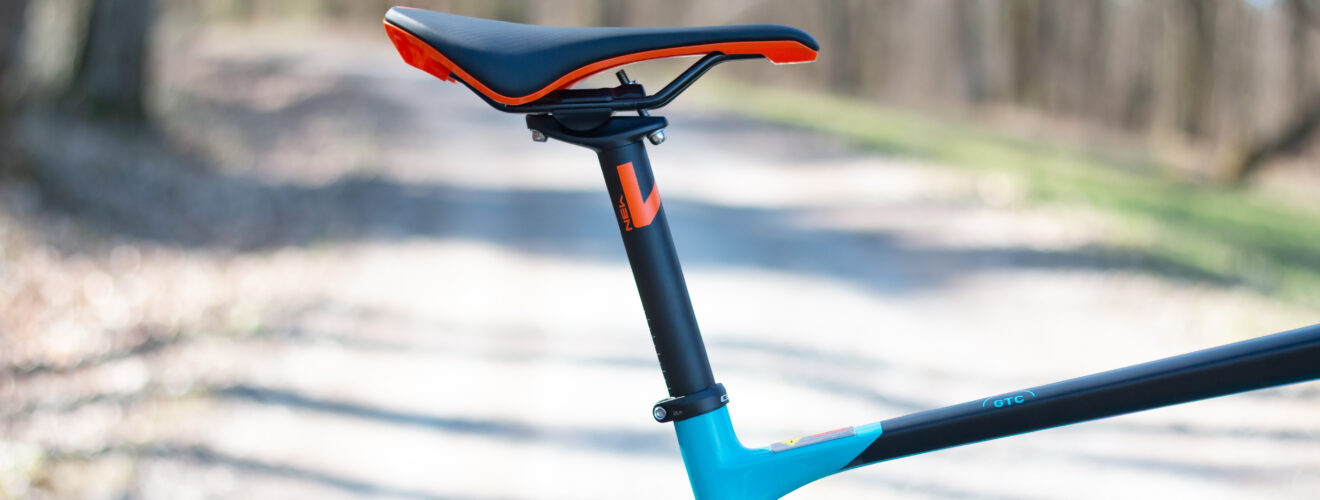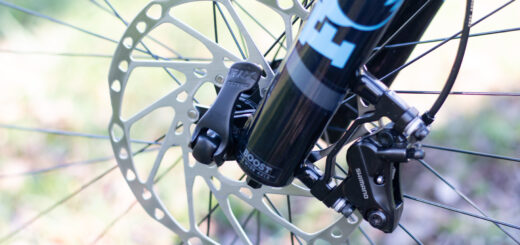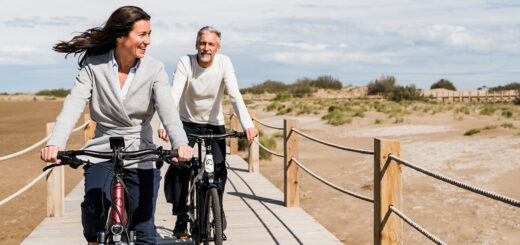How do I calculate the optimum frame height?

Cycling is healthy, we all know that. Cycling trains the cardiovascular system, the lungs and the muscles. A correct sitting position is crucial, because most people sit incorrectly on the bike and risk tension and problems in the back, neck and wrists.
- Recommended(e.g. trekking bike): approx. 70 – 90 degrees between upper arm and back, the arms and wrists are more strained by leaning further forward, a sporty saddle and ergonomic grips are helpful.
- Sporty(e.g. on a racing bike): over 90 degrees between upper arm and back, comfort is not the first priority. Aerodynamics and the best power transmission are important.
- Upright(e.g. on a Dutch bike): approx. 20 – 30 degrees between the upper arm and the back, most of the weight is on the saddle. This is why Dutch bikes usually have a very comfortable saddle.
- Tilted forward(e.g. on a city bike): no more than 60 degrees between upper arm and back, like on a Dutch bike the saddle is designed for an increased load on the buttocks and you generate a higher driving force.
Frame height and frame length are crucial for the correct riding position. You should measure your body and then make the correct adjustments to the bike. For frequent riders who sit on the bike every day, the 70 – 90 degree position is recommended. Mountain bikers have a very individual riding position. On a race bike you sit more sportily than on an enduro bike – depending on how much riding safety is required.
How do I determine the stride length (also called stride height)?
Tip: It is best to have another person help you.
- Take off your shoes. Measure in socks or barefoot.
- It is best to stand upright against a wall dressed in underwear or cycling shorts.
- Push a spirit level or a book up on edge between your thighs as far as possible. A book is advantageous because you can simply hold it against the wall at a 90° angle.
- Measure the distance from the top of the spirit level or book to the floor.
- This is your stride length
Calculate frame height: What is the formula?
- Road bike: stride length x 0.66
- MTB: stride length x 0.57
- City, cross or trekking bike: stride length x 0.67
More than 90 degrees between the upper arm and the back is the correct seating position on a road bike. Aerodynamics and perfect power transmission are important.
Frame height and frame length are crucial. You should measure your body and then make the right adjustments to the bike.
Measure your body
- Measure your stride length (S):
Stand barefoot against a wall with your legs stretched out, push a book into your stride and measure from the floor to the top of the book - Determine torso length (R):
The torso length is calculated from the body length minus the stride length - Determine body length (K):
Body length is measured from the floor to the “V-shaped” indentation on the sternum, the solar plexus - Determine arm length (A)
Hold a pencil in your hand and extend your arm horizontally. Measure from the pen in your fist to the hollow at the top of your shoulder.
Calculate the ideal top tube length:
The top tube length is crucial for an ideal riding position. We show you how to calculate it!
First select a posture (H) that is suitable for you:
- Touring position 0.52
- sporty posture 0.53
- Race posture 0.54
Then determine the stem length (V):
A longer body length means a longer stem length:
| Frame height in cm | Stem length in cm: |
| 52 | 8 |
| 55 | 10 |
| 58 | 12 |
| 61 | 14 |
Now calculate:
Ideal top tube length = ( torso length + arm length ) x posture – stem length
O = ( R + A ) x H – V
How do I calculate the saddle height?
Heel method
Sit on your bike and try to reach the right pedal with your knee extended and your heel on the pedal (it is best to have someone help you so that you do not fall over). The pedal is in the lowest position. If you cannot reach the pedal in this way, the saddle is set too high.
The Hügi Method (named after the Swiss Wilfried Hügi)
After you have calculated your inseam, multiply it by 0.885 to get your saddle height. You measure from the centre of the pedal axle to the top of the saddle.
The LeMond method
Named after the famous cyclist Greg LeMond, who developed this formula with his coach in the 80s. Take your stride length and multiply it by 0.883. You measure from the centre of the pedal axle to the top of the saddle.
The “Exact” method
Inside leg length x 1.09. You also measure from the centre of the pedal axle to the top of the saddle.
To be on the safe side, you are welcome to have your body and bike data accurately measured and adjusted when you buy a bike in our shop.
All information and formulas serve as a guide and do not replace professional body measurement.
The optimum saddle angle
A correct seat distribution is responsible for a healthy riding position. Ideally, the saddle should be horizontal and only slightly tilted. A spirit level is the best way to align it.
The optimal handlebar position
A back-friendly upper body position is achieved when the pelvis tilts slightly forward and a slight hollow back is created. The resulting natural S-shape of the back tightens the muscles and thus prevents injuries.
Handlebar width
The ideal handlebar width is calculated from the shoulder width plus twice the hand width. Mountain bikers usually use wide handlebars to be able to steer the bike better.
Handlebar bend
The wider the handlebars and the more upright the riding position, the greater the handlebar bend.
- Mountain bike: 5 – 16 degrees
- Touring bike: 8 – 20 degrees
- City bike: 25 – 30 degrees
What frame height do I need for a mountain bike?
| Body height | Frame size in cm | EU size | Inch |
| 150 – 155 cm | 33 – 35 cm | XS | 13″ – 14″ inch |
| 155 – 160 cm | 35 – 38 cm | XS | 14″ – 15″ inch |
| 160 – 165 cm | 38 – 40 cm | S | 15″ – 16″ inch |
| 165 – 170 cm | 40 – 43 cm | S/M | 16″ – 17″ inch |
| 170 – 175 cm | 42 – 45 cm | M | 16.5″ – 17.5″ inch |
| 175 – 180 cm | 44 – 47 cm | M | 17.5″ – 18.5″ inch |
| 180 – 185 cm | 46 – 49 cm | L | 18″ – 19″ inch |
| 185 – 190 cm | 49 – 52 cm | L | 19″ – 20″ inch |
| 190 – 195 cm | 51 – 56 cm | XL | 20.5″ – 22″ inch |
| from 195 cm | from 56 cm | XL/XXL | from 22″ inch |
What frame size do I need for a road bike?
| Body size | Frame size road bike | Frame size triathlon |
| 155 – 165 cm | 47 – 51 cm (XS/S) | 46 – 48 cm (XS) |
| 165 – 170 cm | 51 – 53 cm (S/M) | 48 – 50 cm (S/M) |
| 170 – 175 cm | 53 – 55 cm (M) | 50 – 52 cm (M) |
| 175 – 180 cm | 55 – 57 cm (M/L) | 52 – 55 cm (M/L) |
| 180 – 185 cm | 57 – 60 cm (L) | 55 – 57 cm (L) |
| 185 – 190 cm | 60 – 62 cm (L/XL) | 57 – 60 cm (L/XL) |
| 190 – 195 cm | 62 – 64 cm (XL) | 60 – 62 cm (XL) |
| from 195 cm | from 64 cm (XL/XXL) | from 62 cm (XXL) |
What frame size do I need for a trekking bike, cross bike or fitness bike?
| Body size | Frame size |
| 150 – 160 cm | 42 – 47 cm (XSS) |
| 160 – 165 cm | 47 – 50 cm (S/M) |
| 165 – 170 cm | 50 – 52 cm (S/M) |
| 170 – 175 cm | 52 – 55 cm (M) |
| 175 – 180 cm | 54 – 58 cm (M/L) |
| 180 – 185 cm | 56 – 61 cm (L) |
| 185 – 190 cm | 58 – 63 cm (L/XL) |
| 190 – 195 cm | 60 – 66 cm (XL) |
| from 195 cm | from 66 cm (XXL) |
What frame size do I need for a city bike?
| Body size | Frame size |
| 150 – 160 cm | 42 – 48 cm |
| 160 – 170 cm | 47 – 52 cm |
| 170 – 175 cm | 52 – 55 cm |
| 175 – 180 cm | 55 – 58 cm |
| 180 – 185 cm | 58 – 61 cm |
| 185 – 190 cm | 61 – 63 cm |
| 190 – 195 cm | 63 – 66 cm |
| from 195 cm | from 66 cm |



















Recent Comments